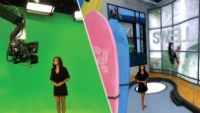Canon drives virtual sets with new wide-angle HD lens

Canon has develoepd a new HD portable lens that offers a 4.3mm wide angle of view, a 14x zoom range and special data connections that facilitate direct digital integration of encoder data for zoom, iris, and focus settings into virtual studio systems for visually appealing results.
The portion of the HJ14ex4.3B lens that enables integration with virtual studio systems is called the Digital Drive unit, which allows camera operators to program lens zoom positions and speeds, as well as focus and iris settings. The unit also includes connectors to output positional data into virtual studio systems. Combined with additional data from camera mounts, data from the HJ14ex4.3B enables the virtual set's render engine to instantly “redraw” the image of the set when on-air studio talent moves or lens settings change. The result is a convincing illusion for TV viewers.
The 2/3in format lens is being used by Intertainment Broadcasting Corp. (iBC), of Irvine CA, where Chris Mapes, vice president of engineering, said they use the data from two HJ14ex4.3B lenses and two Canon HJ22ex7.6B long focal-length HD lenses live-to-air with its virtual studio system six hours a day, seven days a week.
Mapes explained that they take the internal encoder values out of the Canon lenses for zoom and focus, and feed it — along with data feedback from the rest of the HD camera system — into a real-time render engine, which drives the 3-D data comprising the virtual studio set.
The Digital Drive unit incorporates Canon-developed ultra-compact rotary encoders capable of 0.1um position detection. These encoders employ a unique Micro Roofmirror Array (MRA) technology that produces 16-bit resolution of the zoom, iris, and focus control positioning. This provides camera operators with the ability to digitally program precise and repeatable settings into their lenses for focus, iris, and zoom positions and speeds. In addition to MRA capability, the Digital Drive unit also includes a connector to output this lens data so it can be used by virtual studio systems.
Get the TV Tech Newsletter
The professional video industry's #1 source for news, trends and product and tech information. Sign up below.
